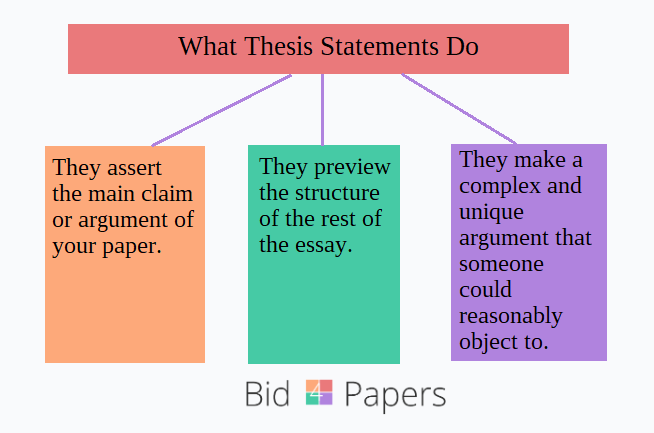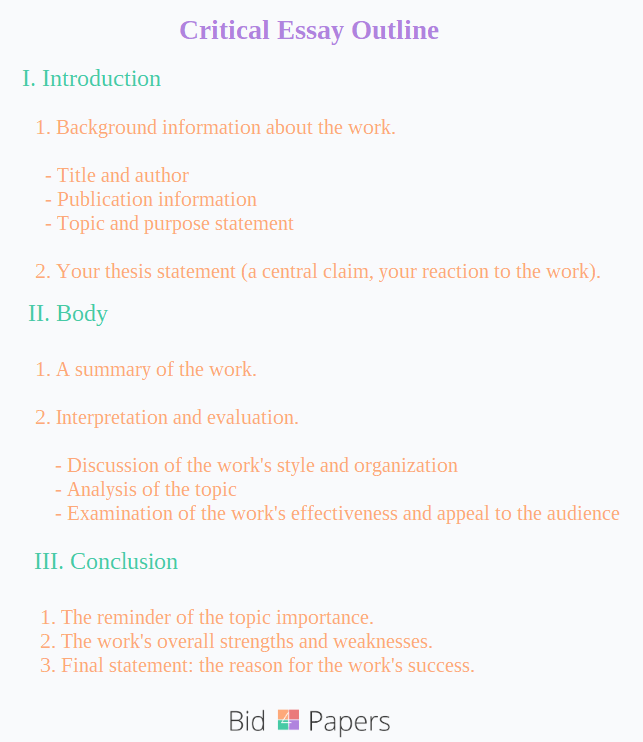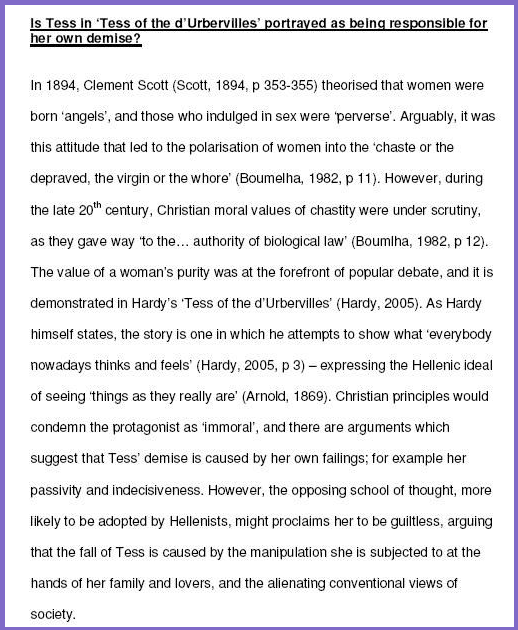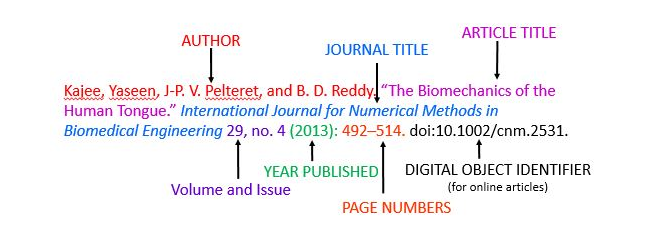You are using an outdated browser. Please upgrade your browser to improve your experience.


How to Write a Critical Essay [Ultimate Guide]
Table of Contents:
1.How to write a critical essay 2.What Makes Essay Critical 3.Steps to Write a Critical Essay 4.Creating a critical essay plan 5.Tips for Writing a Critical Essay 6.Useful techniques used in writing a critical essay 7.Critical Essay Structure 8.Topics for writing a critical essay 9.Critical Essay Examples
How to write a critical essay:
- Examine a source: read it carefully and critically.
- Organize your thoughts: figure out the core claim and evidence, do research of secondary resources.
- State a thesis: make sure it has both a claim and details sustaining it.
- Write an outline.
- Write a draft of your critical essay.
- Edit and improve your essay .
Critical essays are among the most common types of writing assignments in college. Also known as analytical, a critical essay is about evaluating somebody’s work (a movie, a book, an article, etc.) and proving that your evaluation is correct.
The problem is, students often confuse a critical essay with a report, a critical precis , or a review.
In this article, we’ll reveal the core characteristics of a critical essay and learn the right way of writing it.

What Makes Essay Critical
A critical essay has a claim and evidence to prove that claim.
Here you need to analyze the work (a book, a movie, an article, whatever), respond to its central themes, and evaluate how its author conveyed them.
Attention! If the purpose of your paper isn’t to critique but inform or persuade readers of something, it won’t be a critical essay. Check our guides on expository essays or persuasive essays instead.
In other words, your essay is critical if:
- There is a thesis about the central themes of a discussed work in it.
- It explains what an author wanted to say about those themes.
- You describe what techniques an author used to communicate the message.
Please note that “critical” doesn’t mean “negative.” It’s about analysis and interpretation, not judging or disparaging.
When a teacher assigns a critical essay, they want to get a professionally presented and grammatically correct paper with a clear argument and consistent and accurate references to support that argument. They need a paper demonstrating that you’ve read a source, understood its theme, and evaluated the evidence relating to that theme.
Steps to Write a Critical Essay
Before you take a seat and start writing a critical essay, make sure you understand its characteristics and purpose inside out.
You need to analyze and evaluate a work.
Note: Analysis = breaking down and studying the part; evaluation = assessing strengths and weaknesses.
You need to express a central claim of your work in a thesis statement and then support it with evidence in each body paragraph.
Note: The evidence can be either the details from a source (dialogues, imagery, descriptions, text structure, etc.) or secondary resources such as scholarly articles or expert reviews that can help you support your argument.
You need to write a conclusion . Summarize a critical essay, emphasizing its most essential insights.
Long story short, here go your steps to write a critical essay.
Step 1: Examine a Source
You won’t write a critical essay if you don’t understand the subject of evaluation. Let’s say you write an essay on a book. It stands to reason that you need to read it first, right?
So, your first step to writing a critical essay will be critical reading. And while reading, make sure to take as many notes as possible. Utilizing an essay maker can help to organize your thoughts and structure your essay.
Take note of the instruments the author uses to communicate the message. What does he want to say? What words, grammar constructions, or stylistic devices does he use?
Also, think of the questions that come to your mind while reading. Write them down, too.
Step 2: Organize Your Thoughts
Now it’s time to figure out the core topic and problem of a piece. Find its central claim and the evidence demonstrating that claim. What does make it different or similar to other corresponding works?
Brainstorm to come up with what you already know, think, and feel about the topic. Think of related ideas and associations arising when you try to analyze it. Once your thoughts are on paper, start organizing them: group all the ideas and identify the areas for further research.
You might need to do research and find secondary sources such as scholarly articles or online reviews by experts to understand the original piece better. Collect all the necessary references you might later need to give credit in your critical essay.
Step 3: State a Thesis
Your critical essay should have a one-sentence thesis with two components: a claim and details sustaining it. Based on the information you’ve gathered from the subject of evaluation (a book, a movie, etc.) and secondary sources, write a thesis that will specify your essay’s direction.

Hint: When making a claim, answer the question, “What point am I trying to make?” If still in doubt, introduce your idea and evidence to a thesis statement generator : it will craft a thesis draft that you’ll modify later (if needed) to reflect your position better.
Step 4: Write a Critical Essay Outline
You can’t write an essay without outlining. At least, it will help you save time : here you’ll structurize all the points into paragraphs so it would be easier to write them later.
At this stage, you’ll have arguments and evidence to evaluate in essay paragraphs. Decide on the evidence that would support your thesis statement best.
Step 5: Write a Draft
Once the essay outline is ready, it’s time to write. (Yeap, finally!) Begin with an examination (a summary) of the work and respond to its central claim. Then, analyze and evaluate it with the evidence. And finally, conclude your critical essay with the emphasis on its most essential insights.
While writing, remember about academic style: stay formal and objective; use language precisely; remember about references; use transition words in paragraphs to guide readers and help them follow your train of thoughts.
Step 6: Edit and Improve
The best advice here would be to hold your completed draft for a short while and get some rest from writing. Then, read your essay a few times to see all the mistakes. You may do it yourself or ask a friend, a mom, or a groupmate to help you: they’ll see your essay from a different perspective, as readers, so it will be easier for them to identify weak points to edit.
Revise your essay, making all the necessary amendments until you see it’s perfect. To make sure it’s genuinely so, don’t hesitate to ask writing service for professional help .

Creating a critical essay plan
To write critical essay correctly, you will need a work plan. This will make it possible not to be confused by your information and to do the work consistently. More often than not, only three basic steps will suffice:
- The first thing to do is to write an introduction that will allow the topic to be disclosed, give the first argument, and strengthen the thesis.
- Next, you must create the central part, consisting of at least three full paragraphs. Consistently give arguments, facts, figures, and comparisons.
- Conclude with a proper conclusion. You can rephrase the thesis statement to make a circle between the end and the beginning of your paper.
Now you know how to write a critical essay introduction and can get started efficiently.
Tips for Writing a Critical Essay
Writing a critical essay is about your thinking skills. It’s an analysis- and argument-building process, and you need to practice a lot to develop essential skills of thinking. These tips will help you start and write academic papers that work, no matter if that’s a SAT essay , a dialectic essay , or any other type of college writing.
- Practice smart reading. It’s when you read a text, identifying and analyzing its specific details: an author’s claims, how he or she presents those claims, controversies surrounding the message, its strengths and weaknesses, its overall value, etc.
- Read some examples of critical essays. It will help to understand their structure and writing style. But don’t copy others’ ideas, trying to sound smarter! Develop your writing style, use the words you know, and introduce your ideas.
- Start writing a critical essay in advance. Don’t wait until the last moment: you’ll need time to read and evaluate the source, find evidence, introduce your thesis, write, and edit your essay. The more time you have, the better.
- Remember to introduce the author and the work you’re going to evaluate in your essay.
- Avoid the “I think” or “in my opinion” stuff when writing. You need to focus on the work, not yourself. When expressing your opinion, do it third-person and back it up with evidence.
- Always document quotes, paraphrases, and other references you use in essays.
- Resist the temptation of summarizing the source in general. If you start writing lengthy descriptions of all characters and the plot, stop and double-check if this information helps your analysis. Critical essays are about interpretation and evaluation, not retelling the plot.
Useful techniques used in writing a critical essay
Writing critical analysis essays can help you with a few useful tricks that even experts use during their work:
- you need to create a clear thesis statement to follow throughout the paper;
- work properly with textual evidence. Don’t leave only quotes in the paragraph and give clear examples;
- try to break paragraphs in time to create the right pauses for readers and to move from description to critique.
By doing so, your chances of succeeding in your assignment will return several times over!
Critical Essay Structure
Most essay types have a standard structure that includes an introduction (with a thesis statement), a body (paragraphs with arguments and evidence to support the thesis), and a conclusion (with a thesis restatement and essential insights). A critical essay structure is not an exception here.
But before you start writing, craft an outline, aka a roadmap for your essay to make sure you won’t miss any critical detail while writing a draft.
Critical Essay Outline
When you have an essay plan, its writing becomes much easier. Consider the format: as a rule, critical essays have a standard structure that consists of an introductory paragraph, a few body paragraphs, and a conclusion. Use this template that will help you write a detailed outline for your critical essay :

Once you’ve completed the critical essay outline, it’s time to start writing. Do it quickly (you will have time to proofread and edit it later), paying attention to all the details from your outline.
Critical Essay Introduction
All essays have introductions, as it’s a part where you hook readers , tell about the topic and its importance, and, therefore, persuade them to continue reading. But while the purpose of most introductions is to introduce the thesis, a critical essay introduction is more complicated.
Here’s how to write a critical essay introduction:
- First, you need to introduce the author and the title of the work.
- Second, you need to state the author’s main point (of the entire work or the section you’re going to evaluate in your critical essay). Answer the question, “What does the author want readers to remember?”
- Third, you need to state (1-2 sentences) your evaluation of the work. (It will be your thesis statement.)
- And finally, add any background information the reader might need to understand the work’s context (its overall topic, the controversy it might involve, etc.). While it’s not a narrative essay , you need to set the stage: the chances are, your audience didn’t read the work so they wouldn’t understand your essay without the provided background.

Critical Essay Body
It’s the most detailed part of your critical essay, and it involves several sections. Each section addresses a particular detail and evidence to support your thesis.
The first section is the work’s summary.
Write a short, objective, and unbiased report of the work (or its abstract) you’re evaluating in your critical essay. Here you need to tell about the author’s overall point and the main supports he or she offers for that point. Make sure to avoid your personal opinion: write a summary in the third person!
The second section is the work’s interpretation and evaluation.
It’s where your report ends, but your analysis starts. Here you’ll evaluate the work’s strong and weak parts, by the following criteria:
- How accurate is the information in the work you’re criticizing?
- Does it have or lack definitions and key terms?
- Are there any controversies or hidden assumptions?
- Is the author’s language clear?
- Is the author fair? Does he or she cover both sides of the issue, without any bias?
- Is the work’s organization logical? Does the author present all the points in a meaningful way?
- Are there any gaps in his or her arguments?
- What are (if any) the author’s fallacies? (Too emotional language, over-simplification, generalization, etc.)
After that, your interpretation comes. It’s not about judging (evaluation) anymore, but your response (opinion) on this work.
Ask yourself:
- Where do I agree or disagree with the author?
- What does he or she get right or wrong?
- Would I recommend this work as a credible research source?
Your interpretation is, actually, the thesis of your essay. In this section, you’ll support the opinion you expressed in the thesis.
Critical Essay Conclusion
Yes, finally! Here comes the time to write a critical essay conclusion, and it doesn’t have to be too long. It’s like a reworded introduction, where you repeat the importance of your topic, reiterate the points you discussed, and summarize your interpretation.
- Remind readers why this topic is essential.
- Combine your evaluation and interpretation to focus on the work’s overall strengths and weaknesses.
- State what makes the work so popular and successful.
Topics for writing a critical essay
A properly assembled structure of a critical essay will allow you to work with almost any topic without any problems. However, choosing it can take a while, so here are some cool examples to help you start proactively.
Choose the topic closest to you and begin to study it in depth. This will allow you to accumulate the right argument and use it competently and quickly. Don’t forget to learn how to structure a critical essay and get to writing!
Critical Essay Examples
With tons of resources available online today, it’s not that difficult to find critical essay examples. But it’s challenging to find good ones . Here we have a couple of essay abstracts for you to get an idea of what a critical essay looks and sounds. Feel free to use them for informational and educational purposes only; don’t copy them word by word in your essays to avoid duplications and accusations of plagiarism from your educators.
Critical essay example #1 (the abstract, taken from examples.com):

Critical essay example #2 (the abstract, taken from examples.com):

More examples and explanations:
- The University of Queensland: Critical reading and analysis
- Thompson Rivers University: Critical analysis template
- Nova Southeastern University : Critical essay
FAQ about Critical Essay
And now, for the most interesting part:
To make a long story short for you, here go answers to the most frequently asked questions about critical essay writing. Read them if you want your analytical essay to be A-worthy.
- What type of language should be used in a critical analysis essay?
Make sure to use a formal language in critical essays. It’s about grammatical and pronunciation norms used in intellectual and academic activities. And since your essay is analytical and requires credibility, a formal language is what you need to make it sound so.
- How to cite a critical essay?
For citing critical essays, use the MLA format. Name the author first, followed by the title. Then, specify the publication details, including the pages from where you take the quote or reference.

- How to write a critical essay on movies?
Do it in the same ways as with books or articles. Watch the movie several times, engage with it critically: identify its core focus and message, interpret and evaluate it in the essay, and come up with the essential insights this movie gives to the audience.
- How to write a self-critical essay?
Self-critical essays are about analyzing and evaluating your own writings. As a rule, educators assign them for you to reflect on your progress as a writer.
Such essays are not that difficult to craft. Follow the basic structure of a critical essay: write an introduction stating your thesis, a few body paragraphs analyzing your strengths and weaknesses as a writer, and a conclusion that restates your thesis and sums up what you’ve learned about yourself.
- Can a critical essay be in the first person?
Yes, if you write a self-critical essay. But if you write about others’ works, use the third person only.
In a Word…
Don’t be afraid of writing a critical essay! Yes, essays are many, and it might seem impossible to learn the differences between them and the rules of writing them. But their basic structure is the same. All you need to do is identify the purpose of your assigned work and outline it accordingly.
Critical essays are about analyzing and evaluating the work of other writers. So, just read it, figure out what the authors wanted to say, think of whether you agree or disagree with them, and write a critical essay about all this stuff. Therefore, you develop critical thinking. You learn to introduce and prove your arguments.
And you understand how to share ideas with others so they’d listen and support you.
Related posts
- What Is the Difference between Primary and Secondary Sources
- Common Types of Plagiarism with Examples
- Exemplification Essay – Ideas and Tips
Our Writing Guides
How to Write an Essay Introduction (with Examples)

The introduction of an essay plays a critical role in engaging the reader and providing contextual information about the topic. It sets the stage for the rest of the essay, establishes the tone and style, and motivates the reader to continue reading.
Table of Contents
What is an essay introduction , what to include in an essay introduction, how to create an essay structure , step-by-step process for writing an essay introduction , how to write an introduction paragraph , how to write a hook for your essay , how to include background information , how to write a thesis statement .
- Argumentative Essay Introduction Example:
- Expository Essay Introduction Example
Literary Analysis Essay Introduction Example
Check and revise – checklist for essay introduction , key takeaways , frequently asked questions .
An introduction is the opening section of an essay, paper, or other written work. It introduces the topic and provides background information, context, and an overview of what the reader can expect from the rest of the work. 1 The key is to be concise and to the point, providing enough information to engage the reader without delving into excessive detail.
The essay introduction is crucial as it sets the tone for the entire piece and provides the reader with a roadmap of what to expect. Here are key elements to include in your essay introduction:
- Hook : Start with an attention-grabbing statement or question to engage the reader. This could be a surprising fact, a relevant quote, or a compelling anecdote.
- Background information : Provide context and background information to help the reader understand the topic. This can include historical information, definitions of key terms, or an overview of the current state of affairs related to your topic.
- Thesis statement : Clearly state your main argument or position on the topic. Your thesis should be concise and specific, providing a clear direction for your essay.
Before we get into how to write an essay introduction, we need to know how it is structured. The structure of an essay is crucial for organizing your thoughts and presenting them clearly and logically. It is divided as follows: 2
- Introduction: The introduction should grab the reader’s attention with a hook, provide context, and include a thesis statement that presents the main argument or purpose of the essay.
- Body: The body should consist of focused paragraphs that support your thesis statement using evidence and analysis. Each paragraph should concentrate on a single central idea or argument and provide evidence, examples, or analysis to back it up.
- Conclusion: The conclusion should summarize the main points and restate the thesis differently. End with a final statement that leaves a lasting impression on the reader. Avoid new information or arguments.

Here’s a step-by-step guide on how to write an essay introduction:
- Start with a Hook : Begin your introduction paragraph with an attention-grabbing statement, question, quote, or anecdote related to your topic. The hook should pique the reader’s interest and encourage them to continue reading.
- Provide Background Information : This helps the reader understand the relevance and importance of the topic.
- State Your Thesis Statement : The last sentence is the main argument or point of your essay. It should be clear, concise, and directly address the topic of your essay.
- Preview the Main Points : This gives the reader an idea of what to expect and how you will support your thesis.
- Keep it Concise and Clear : Avoid going into too much detail or including information not directly relevant to your topic.
- Revise : Revise your introduction after you’ve written the rest of your essay to ensure it aligns with your final argument.
Here’s an example of an essay introduction paragraph about the importance of education:
Education is often viewed as a fundamental human right and a key social and economic development driver. As Nelson Mandela once famously said, “Education is the most powerful weapon which you can use to change the world.” It is the key to unlocking a wide range of opportunities and benefits for individuals, societies, and nations. In today’s constantly evolving world, education has become even more critical. It has expanded beyond traditional classroom learning to include digital and remote learning, making education more accessible and convenient. This essay will delve into the importance of education in empowering individuals to achieve their dreams, improving societies by promoting social justice and equality, and driving economic growth by developing a skilled workforce and promoting innovation.
This introduction paragraph example includes a hook (the quote by Nelson Mandela), provides some background information on education, and states the thesis statement (the importance of education).
This is one of the key steps in how to write an essay introduction. Crafting a compelling hook is vital because it sets the tone for your entire essay and determines whether your readers will stay interested. A good hook draws the reader in and sets the stage for the rest of your essay.
- Avoid Dry Fact : Instead of simply stating a bland fact, try to make it engaging and relevant to your topic. For example, if you’re writing about the benefits of exercise, you could start with a startling statistic like, “Did you know that regular exercise can increase your lifespan by up to seven years?”
- Avoid Using a Dictionary Definition : While definitions can be informative, they’re not always the most captivating way to start an essay. Instead, try to use a quote, anecdote, or provocative question to pique the reader’s interest. For instance, if you’re writing about freedom, you could begin with a quote from a famous freedom fighter or philosopher.
- Do Not Just State a Fact That the Reader Already Knows : This ties back to the first point—your hook should surprise or intrigue the reader. For Here’s an introduction paragraph example, if you’re writing about climate change, you could start with a thought-provoking statement like, “Despite overwhelming evidence, many people still refuse to believe in the reality of climate change.”
Including background information in the introduction section of your essay is important to provide context and establish the relevance of your topic. When writing the background information, you can follow these steps:
- Start with a General Statement: Begin with a general statement about the topic and gradually narrow it down to your specific focus. For example, when discussing the impact of social media, you can begin by making a broad statement about social media and its widespread use in today’s society, as follows: “Social media has become an integral part of modern life, with billions of users worldwide.”
- Define Key Terms : Define any key terms or concepts that may be unfamiliar to your readers but are essential for understanding your argument.
- Provide Relevant Statistics: Use statistics or facts to highlight the significance of the issue you’re discussing. For instance, “According to a report by Statista, the number of social media users is expected to reach 4.41 billion by 2025.”
- Discuss the Evolution: Mention previous research or studies that have been conducted on the topic, especially those that are relevant to your argument. Mention key milestones or developments that have shaped its current impact. You can also outline some of the major effects of social media. For example, you can briefly describe how social media has evolved, including positives such as increased connectivity and issues like cyberbullying and privacy concerns.
- Transition to Your Thesis: Use the background information to lead into your thesis statement, which should clearly state the main argument or purpose of your essay. For example, “Given its pervasive influence, it is crucial to examine the impact of social media on mental health.”

A thesis statement is a concise summary of the main point or claim of an essay, research paper, or other type of academic writing. It appears near the end of the introduction. Here’s how to write a thesis statement:
- Identify the topic: Start by identifying the topic of your essay. For example, if your essay is about the importance of exercise for overall health, your topic is “exercise.”
- State your position: Next, state your position or claim about the topic. This is the main argument or point you want to make. For example, if you believe that regular exercise is crucial for maintaining good health, your position could be: “Regular exercise is essential for maintaining good health.”
- Support your position: Provide a brief overview of the reasons or evidence that support your position. These will be the main points of your essay. For example, if you’re writing an essay about the importance of exercise, you could mention the physical health benefits, mental health benefits, and the role of exercise in disease prevention.
- Make it specific: Ensure your thesis statement clearly states what you will discuss in your essay. For example, instead of saying, “Exercise is good for you,” you could say, “Regular exercise, including cardiovascular and strength training, can improve overall health and reduce the risk of chronic diseases.”
Examples of essay introduction
Here are examples of essay introductions for different types of essays:
Argumentative Essay Introduction Example:
Topic: Should the voting age be lowered to 16?
“The question of whether the voting age should be lowered to 16 has sparked nationwide debate. While some argue that 16-year-olds lack the requisite maturity and knowledge to make informed decisions, others argue that doing so would imbue young people with agency and give them a voice in shaping their future.”
Expository Essay Introduction Example
Topic: The benefits of regular exercise
“In today’s fast-paced world, the importance of regular exercise cannot be overstated. From improving physical health to boosting mental well-being, the benefits of exercise are numerous and far-reaching. This essay will examine the various advantages of regular exercise and provide tips on incorporating it into your daily routine.”
Text: “To Kill a Mockingbird” by Harper Lee
“Harper Lee’s novel, ‘To Kill a Mockingbird,’ is a timeless classic that explores themes of racism, injustice, and morality in the American South. Through the eyes of young Scout Finch, the reader is taken on a journey that challenges societal norms and forces characters to confront their prejudices. This essay will analyze the novel’s use of symbolism, character development, and narrative structure to uncover its deeper meaning and relevance to contemporary society.”
- Engaging and Relevant First Sentence : The opening sentence captures the reader’s attention and relates directly to the topic.
- Background Information : Enough background information is introduced to provide context for the thesis statement.
- Definition of Important Terms : Key terms or concepts that might be unfamiliar to the audience or are central to the argument are defined.
- Clear Thesis Statement : The thesis statement presents the main point or argument of the essay.
- Relevance to Main Body : Everything in the introduction directly relates to and sets up the discussion in the main body of the essay.

Writing a strong introduction is crucial for setting the tone and context of your essay. Here are the key takeaways for how to write essay introduction: 3
- Hook the Reader : Start with an engaging hook to grab the reader’s attention. This could be a compelling question, a surprising fact, a relevant quote, or an anecdote.
- Provide Background : Give a brief overview of the topic, setting the context and stage for the discussion.
- Thesis Statement : State your thesis, which is the main argument or point of your essay. It should be concise, clear, and specific.
- Preview the Structure : Outline the main points or arguments to help the reader understand the organization of your essay.
- Keep it Concise : Avoid including unnecessary details or information not directly related to your thesis.
- Revise and Edit : Revise your introduction to ensure clarity, coherence, and relevance. Check for grammar and spelling errors.
- Seek Feedback : Get feedback from peers or instructors to improve your introduction further.
The purpose of an essay introduction is to give an overview of the topic, context, and main ideas of the essay. It is meant to engage the reader, establish the tone for the rest of the essay, and introduce the thesis statement or central argument.
An essay introduction typically ranges from 5-10% of the total word count. For example, in a 1,000-word essay, the introduction would be roughly 50-100 words. However, the length can vary depending on the complexity of the topic and the overall length of the essay.
An essay introduction is critical in engaging the reader and providing contextual information about the topic. To ensure its effectiveness, consider incorporating these key elements: a compelling hook, background information, a clear thesis statement, an outline of the essay’s scope, a smooth transition to the body, and optional signposting sentences.
The process of writing an essay introduction is not necessarily straightforward, but there are several strategies that can be employed to achieve this end. When experiencing difficulty initiating the process, consider the following techniques: begin with an anecdote, a quotation, an image, a question, or a startling fact to pique the reader’s interest. It may also be helpful to consider the five W’s of journalism: who, what, when, where, why, and how. For instance, an anecdotal opening could be structured as follows: “As I ascended the stage, momentarily blinded by the intense lights, I could sense the weight of a hundred eyes upon me, anticipating my next move. The topic of discussion was climate change, a subject I was passionate about, and it was my first public speaking event. Little did I know , that pivotal moment would not only alter my perspective but also chart my life’s course.”
Crafting a compelling thesis statement for your introduction paragraph is crucial to grab your reader’s attention. To achieve this, avoid using overused phrases such as “In this paper, I will write about” or “I will focus on” as they lack originality. Instead, strive to engage your reader by substantiating your stance or proposition with a “so what” clause. While writing your thesis statement, aim to be precise, succinct, and clear in conveying your main argument.
To create an effective essay introduction, ensure it is clear, engaging, relevant, and contains a concise thesis statement. It should transition smoothly into the essay and be long enough to cover necessary points but not become overwhelming. Seek feedback from peers or instructors to assess its effectiveness.
References
- Cui, L. (2022). Unit 6 Essay Introduction. Building Academic Writing Skills .
- West, H., Malcolm, G., Keywood, S., & Hill, J. (2019). Writing a successful essay. Journal of Geography in Higher Education , 43 (4), 609-617.
- Beavers, M. E., Thoune, D. L., & McBeth, M. (2023). Bibliographic Essay: Reading, Researching, Teaching, and Writing with Hooks: A Queer Literacy Sponsorship. College English, 85(3), 230-242.
Paperpal is a comprehensive AI writing toolkit that helps students and researchers achieve 2x the writing in half the time. It leverages 21+ years of STM experience and insights from millions of research articles to provide in-depth academic writing, language editing, and submission readiness support to help you write better, faster.
Get accurate academic translations, rewriting support, grammar checks, vocabulary suggestions, and generative AI assistance that delivers human precision at machine speed. Try for free or upgrade to Paperpal Prime starting at US$19 a month to access premium features, including consistency, plagiarism, and 30+ submission readiness checks to help you succeed.
Experience the future of academic writing – Sign up to Paperpal and start writing for free!
Related Reads:
- What is an Argumentative Essay? How to Write It (With Examples)
- How to Paraphrase Research Papers Effectively
- How to Cite Social Media Sources in Academic Writing?
- How Long Should a Chapter Be?
Similarity Checks: The Author’s Guide to Plagiarism and Responsible Writing
Types of plagiarism and 6 tips to avoid it in your writing , you may also like, do plagiarism checkers detect ai content, word choice problems: how to use the right..., how to avoid plagiarism when using generative ai..., what are journal guidelines on using generative ai..., types of plagiarism and 6 tips to avoid..., similarity checks: the author’s guide to plagiarism and..., what is a master’s thesis: a guide for..., should you use ai tools like chatgpt for..., what are the benefits of generative ai for..., how to avoid plagiarism tips and advice for....

IMAGES
VIDEO
COMMENTS
Step 3: State a Thesis. Your critical essay should have a one-sentence thesis with two components: a claim and details sustaining it. Based on the information you’ve gathered from the subject of evaluation (a book, a movie, etc.) and secondary sources, write a thesis that will specify your essay’s direction.
Here are the key takeaways for how to write essay introduction: 3. Hook the Reader: Start with an engaging hook to grab the reader’s attention. This could be a compelling question, a surprising fact, a relevant quote, or an anecdote. Provide Background: Give a brief overview of the topic, setting the context and stage for the discussion.
Below are nine organizational and writing tips to help you craft the best possible critical analysis essay. 1. Read Thoroughly and Carefully. You will need to accurately represent an author's point of view and techniques. Be sure you truly understand them before you begin the writing process. 2.